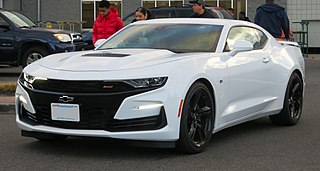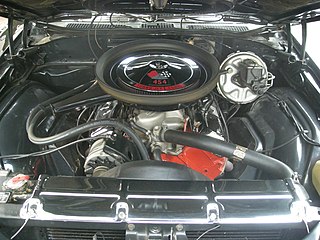
Chevrolet, colloquially referred to as Chevy, is an American automobile division of the manufacturer General Motors (GM).

The Chevrolet Corvette is a line of American two-door, two-seater sports cars, manufactured and marketed by GM, under the Chevrolet marque, since 1953.

Muscle car is a description according to Merriam-Webster Dictionary that came to use in 1966 for "a group of American-made two-door sports coupes with powerful engines designed for high-performance driving." The Britannica Dictionary describes these as "an American-made two-door sports car with a powerful engine."

The Chevrolet Camaro is a mid-size American automobile manufactured by Chevrolet, classified as a pony car. It first went on sale on September 29, 1966, for the 1967 model year and was designed to compete with the Ford Mustang. The Camaro shared its platform and major components with the Firebird, produced by General Motors' Pontiac division that was also introduced for 1967.

The Pontiac Firebird is an American automobile built and produced by Pontiac from the 1967 to 2002 model years. Designed as a pony car to compete with the Ford Mustang, it was introduced on February 23, 1967, five months after GM's Chevrolet division's platform-sharing Camaro. This also coincided with the release of the 1967 Mercury Cougar, Ford's upscale, platform-sharing version of the Mustang. The name "Firebird" was also previously used by GM for the General Motors Firebird in the 1950s and early 1960s concept cars.
A replacement automobile engine is an engine or a major part of one that is sold individually without any other parts required to make a functional car. These engines are produced either as aftermarket parts or as reproductions of an engine that has gone out of production.

Pony car is an American car classification for affordable, compact, highly styled coupés or convertibles with a "sporty" or performance-oriented image. Common characteristics include rear-wheel drive, a long hood, a short decklid, a wide range of options to individualize each car and use of mass-produced parts shared with other models. The popularity of pony cars is largely due to the launch of the Ford Mustang in 1964.
The F platform, or F-body, was General Motors' rear-wheel drive pony car automobile platform from 1967 until 2002. It was based partially on the GM X platform, which was used for compact applications instead of the sporting intent of the F-Body. The only two vehicles to have been built using the F-Body platform are the Chevrolet Camaro and the Pontiac Firebird. The fourth character in the Vehicle Identification Number for an F-body car is "F" on model year 1985 and up vehicles. Earlier Camaros and Firebirds had differing VIN codes, but are now commonly referred to as F-bodies.

The General Motors LS-based small-block engines are a family of V8 and V6 engines designed and manufactured by American automotive company General Motors. First introduced in 1997, the family is a continuation of the earlier first- and second-generation Chevrolet small-block engine, of which over 100 million have been produced altogether, and is also considered to be one of the most popular V8 engines ever. Spanning three generations, a new, sixth generation is expected to enter production soon. Various small-block V8s were and still are available as crate engines.

The Chevrolet Mark Engines colloquially referred to as the big block is a family of large-displacement, naturally-aspirated, 90°, overhead valve, gasoline-powered, V8 engines; that were developed and produced by the Chevrolet Division of General Motors, from the 1950s until present.

The Chevrolet small-block engine is a series of gasoline-powered V8 automobile engines, produced by the Chevrolet division of General Motors between 1954 and 2003, using the same basic engine block. Referred to as a "small-block" for its size relative to the physically much larger Chevrolet big-block engines, the small block family spanned from 262 cu in (4.3 L) to 400 cu in (6.6 L) in displacement. Engineer Ed Cole is credited with leading the design for this engine. The engine block and cylinder heads were cast at Saginaw Metal Casting Operations in Saginaw, Michigan.

Specialty Equipment Market Association (SEMA) of the automobile aftermarket was formed in 1963 by Paul Schiefer, Roy Richter, Ed Iskenderian, Els Lohn, Willie Garner, Bob Hedman, Robert E. Wyman, John Bartlett, Phil Weiand Jr, Al Segal, Dean Moon, and Vic Edelbrock Jr. and now consists of 6,383 companies worldwide, bringing together aftermarket manufacturers, original equipment manufacturers (OEM), media, car dealers, specialty equipment distributors, installers, retailers, and restoration specialists.

Lingenfelter Performance Engineering (LPE) is an American automotive engineering company specializing in high-performance automobile modifications, specifically engines and induction systems. Now headquartered in Brighton, Michigan the company was founded by and named for NHRA driver John Lingenfelter in Decatur, IN. Over the decades since its founding, LPE has been creating high-performance versions of many GM vehicles, such as the F-Bodies, B Bodies, Corvette, CTS-V, GTO, Silverado, Suburban, Tahoe, Escalade, Denali, SSR, Hummer H2, and Sierra. Furthermore, it has also created performance enhancement packages for the Dodge Viper and Plymouth Prowler.
Chevrolet Performance, formerly GM Performance Parts, is an automotive performance parts brand that sells everything from camshafts and cylinder heads to high-performance crate engines and upgrades for late-model vehicles. It was founded in 1967 to support the Trans-Am Camaro race teams. Chevrolet Performance was formed as a way to support all the various Trans Am teams across the United States, but the brand saw enough demand to start selling high-performance parts to the general public. Today, Chevrolet Performance not only sells performance parts, but also helps develop Chevrolet's high-performance vehicles and supports teams in nearly every form of automotive racing.

The fifth-generation Chevrolet Camaro is a pony car that was manufactured by American automobile manufacturer Chevrolet from 2010 to 2015 model years. It is the fifth distinct generation of the muscle/pony car to be produced since its original introduction in 1967. Production of the fifth generation model began on March 16, 2009 after several years on hiatus since the previous generation's production ended in 2002 and went on sale to the public in April 2009 for the 2010 model year.

The fourth-generation Chevrolet Camaro is a pony car that was produced by American automobile manufacturer General Motors for the 1993 through 2002 model years. It was introduced on an updated F-body platform but retained the same characteristic since the first-generation's introduction back in 1967: two doors, coupe or convertible bodystyles, rear-wheel drive, and a choice of 6-cylinder and V8 engines. The Camaro was revised in 1998 with both exterior and engine changes. General Motors discontinued production of the fourth generation of the Camaro due to slow sales, a deteriorated sports coupé market, and plant overcapacity.

The third-generation Chevrolet Camaro is an American pony car which was introduced for the 1982 model year by Chevrolet. It continued to use General Motors' F-body platform and produced a "20th Anniversary Commemorative Edition" for 1987 and "25th Anniversary Heritage Edition" for 1992. These were also the first Camaros with factory fuel injection, four-speed automatic transmissions, five-speed manual transmissions, four-cylinder engines, 16-inch wheels, and hatchback bodies. For 1987 a convertible Camaro was reintroduced, converted by ASC in relatively small numbers. The third-generation Camaro continued through the 1992 model year.

The first-generation Chevrolet Camaro is an American muscle car introduced by Chevrolet in the fall of 1966 for the 1967 model year. It used a brand-new rear-wheel-drive GM F-body platform and was available as a 2-door, 2+2 seat, hardtop, and convertible. The F-body was shared with the Pontiac Firebird for all generations. A 230 cu in Chevrolet straight-6 was standard, with several Chevy V8s available as options. The first-generation Camaro was built through the 1969 model year.

The sixth-generation Chevrolet Camaro is an American pony car. Produced by automobile manufacturer Chevrolet, it was first introduced to the public on May 16, 2015. Sales started in 2015 for the 2016 model year. The Camaro now utilizes the GM Alpha platform shared with the Cadillac ATS and CTS and features MacPherson struts in front, rather than the former multi-link setup. General Motors claims that 70 percent of architectural components in the new Camaro are unique to the car.

Jeff Schwartz is an American protouring car builder/designer and former professional road racer who brought to market the first Bolt-in Muscle Car Chassis for GM A-body cars. In his modified and equipped cars, Schwartz is a six-time winner of the Car Craft Magazine's Real Street Eliminator competition with his fifth and sixth win at the ProAm Invitational in Milwaukee, WI in 2015. In 2013, Schwartz won "Popular Hot Rodding Magazine's Muscle Car of the Year" with his 1981 Twin Turbo TransAm and was voted Car Craft Magazine's "Pro-Builder of the Year" with Jake Wallace's Twin Turbo 1967 Chevy Malibu. In 2017, Schwartz and his crew won his second Car Craft Pro-Builder Award with a right hand drive 1970 Cuda. He is the owner of Schwartz Performance in Woodstock, IL, the founder of the Schwartz Motocross History Museum in McHenry, IL and the father of two children.

















